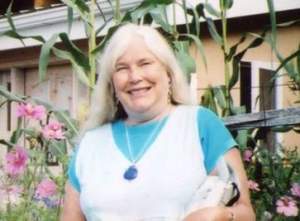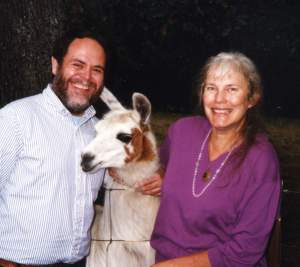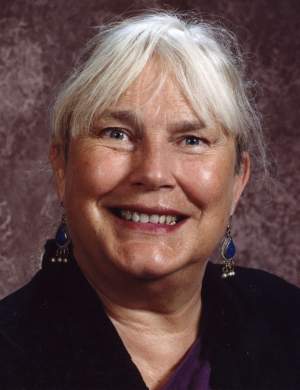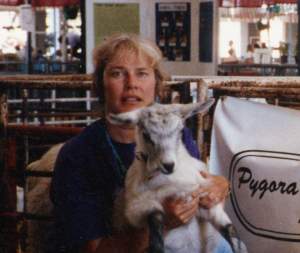|
The
Story of the
PBA
- A
Story
of
Fluff
Pygoras were developed by Katharine Jorgensen of Oregon City, Oregon in the 1980s. How did she come to breed these cute, fuzzy, hardy little goats?
Katharine was a National Pygmy Goat Association pygmy breeder and a 4-H pygmy goat judge, and she loved fiber. Because she enjoyed spinning, knitting and weaving, it wasn’t surprising that on a trip through an indian reservation in the southwest some longhaired colored goats wowed her. She decided she wanted to make colored mohair. “I thought: ‘wouldn’t it be wonderful to have a goat that produced mohair the color of the blue-gray grizzle of pygmy goats?’ I wanted to try and create a mohair-type goat and the traits that were best from both breeds.” (Precious Fibers Magazine, Jan. 1986, p.14-15).
|
The colored, cashmere-like, undercoat of Katharine’s pygmies was too short to use. Her solution was to breed her NPGA pygmy does to an AAGBA Angora buck. She just knew she would get long, colored mohair. What she got were white, fluffy kids whose fleece wasn’t true mohair or true cashmere. It had properties of both types.
After a couple of generations, she started getting color. By the early 1980s, five years of line breeding an Angora doe to an unrelated Pygora™ buck finally resulted in the beautiful grey-grizzled goat Katharine dreamed of. The potential for champagne and honey browns also was present because of the pygmy’s color genetics. By 1986, fleeces were often 5 inches long, had nice crimp and appeared in pure white, silver and gray.
|

Katharine
Jorgensen
|
|

Katharine
and
Jerry
Jorgensen
and
their
llama,
Hummer
|
Katharine also noticed three distinct fiber types: a type-A goat that produced fiber similar to kid mohair, a type-B goat that produced fiber with characteristics of both mohair and cashmere, and a type-C goat that produced a cashmere-like fiber. Katharine was quite proud that a commercial cashmere processing company was happy to buy her C fleeces as cashmere. She also noticed that Pygoras kept the fineness of their fleece even into their teens.
|
|
Her enthusiasm for her new creation was contagious, and everyone who bred for the cross noticed that the goats bred true. Katharine knew she had established a new breed of fiber goat and it needed a name. She considered calling them “Homestead Goats”, because they were large enough to produce fleece, meat, milk and pelts. In the end she decided to combine the name of the two parent breeds and invented the word Pygora.
In 1987, the Pygora Breeders Association (PBA) was started with 10 members. In order to track genealogy and breed for consistent traits, Katharine started a registry and a newsletter. In 1990, when she felt she had seen enough Pygoras, Katharine established a committee to write breed standards and by-laws for the PBA. The first committee members were Dr. Kay Orlando, a veterinarian, Sonia Hall, Marilyn Moore and Chris Utterback.
Right from the start, Katharine knew how important the breed standards were. She wanted to emphasize good conformation, hardiness and natural kidding. She also wanted to make sure people didn’t turn this useful animal that produced lots of fiber each year into a pure pet that was too small to kid on its own and only produced small amounts of fiber. She insisted on a minimum height requirement and no maximum height. Her view was “more is better”.
To keep breed purity, Katharine insisted on allowing only goats from the American Angora Goat Breeder’s Association and the National Pygmy Goat Association into the Pygora herdbook. Since AAGBA goats must be white, Pygora colors were limited to white and those found in the pygmy. Soon after the breed standards were completed, a Judge’s Training Manual and test were created by Katharine, Mary Jane Ontiveros and Chris Utterback. Then the first PBA sanctioned judges were licensed. Since then the manual has been reviewed twice and updated once. The reviews were conducted by Jackie Liner, Jill Gallagher, Fran Bishop, Lisa Roskopf, Lisa Zietz and Chris Utterback.
|


Katharine
Jorgensen
and
one
of
her
Pygora
goats
|
Katharine is a very interesting and knowledgeable person. She worked as a teacher and librarian when not out tending goats. She also is a wonderful artist. She moved her farm, Misty Meadows, to the dry climate of New Mexico where she lives with her husband, Jerry, a few Pygoras and a llama.
Since the beginning, the PBA has had many dedicated volunteers who work behind the scenes, donating time and money to get the word out about Pygoras. Currently we have many very active committees, and there is room for you.
Katharine Jorgensen
October 18th, 1941 - November 5, 2018
Katharine Jorgensen, creator of the Pygora goat, passed away at home on November 5th, 2018. She was 77.
Katharine was born in Pittsburgh, PA on October 18th, 1941. Less than two months later her dad was called up to serve in the U.S. Army. Being an “Army brat”, Katharine lived all over the world in her childhood. Stops along the way included Munich, Germany, New Jersey, Okinawa, Georgia, Illinois, and finally Carmel Valley, CA, which is near the Fort Ord Army base. She earned a Bachelors degree in Fine Art at San Francisco State, and later a Masters degree in Early Childhood Education at the University of New Mexico.
She has one son, Benjamin, age 51, from her first marriage to Bruce Lowney. She also has a grandson, Alexander, age 11. In 1971 she got together with (and married in 1977) Jerry Jorgensen, and they stayed together for life. She taught both children and future teachers at the college level, in both New Mexico and Oregon. She also worked as a librarian for many years, and was an accomplished watercolor artist and ceramicist.
However, I believe her most important accomplishment was cross-breeding Angora and Pygmy goats to create the Pygora goat that you all enjoy. Katharine's first goat was an orphaned Angora goat that she bottle fed. She had to leave this goat behind when we moved to Oregon in 1976, but she was soon raising and showing pygmy goats. She began breeding what became Pygoras in the 1980's, consulting with a geneticist about how to breed for desired characteristics. When what are now known as the B and C type Pygoras emerged from crossing Pygora to Pygora, she was a little surprised and a lot pleased with the results. With Chris Utterback's help, who was also an early Pygora breeder, they founded the Pygora Breeders Association, and the rest is history.
She was glad to see other people taking up the job of perpetuating Pygora goats and PBA, and seeing these wonderful animals spread throughout the country. Thank you so much to all of you for raising more of these useful pets and practical farm animals.
Yours truly, Jerry Jorgensen
|